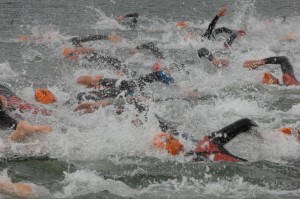
For many triathletes, the swim can be the most challenging and intimidating part of the sport, especially in the open water. The chaos of the swim start, the fear of getting pushed under, kicked in the face, or inhaling a lungful of water can all make for an anxious situation, even for experienced triathletes. The good news is that through preparation and training, and the use of some specific drills, you can prepare for these challenges and take a lot of the fear out of the swim.
First of all, what are some of the variables that triathletes need to prepare for? Open water swimming is different for a number of reasons, including the following: Lack of visibility, deep water where you can’t touch the bottom, no walls to push off every 25 or 50 meters, and contact with other swimmers. These are things that most swimmers don’t encounter in their day to day training, but you can simulate them with the following drills and games.
1. Head up freestyle: This drill helps to prepare you for the demands of having to sight off buoys while you swim. Having to lift your head every 5-10 strokes will use a lot of unfamiliar muscles, leading to fatigue which can also affect your performance on the bike and the run. To perform this drill, swim with your head out of the water with your eyes up, looking directly forward. Keep your chin just above the surface and don’t turn your head to the side to breathe. It helps to place something to focus on at the end of your lane, like a traffic cone. If possible, get a friend to move the traffic cone after each lap so you have to re-orient yourself a little. You can do 6-12x25m repeats of this drill with 10-15 seconds rest
after each 25, or you can include it in a longer swim. For example, you can swim a 400 and do every 4th lap head up freestyle.
2. Eyes closed freestyle: Please be careful when swimming this drill! Use caution and make sure that you don’t swim into the wall or the lane lines. For this one you will swim with your eyes closed, and only open them when you lift your head to sight. Sight every 5 or six strokes. This drill will help you to become more accustomed to the disoriented feeling of swimming in water with low viability. Also, this is best to do when you have a lane to yourself. Don’t do this in a crowded lane when you may risk injuring yourself or another swimmer.
3. Open water turns: These are simple to do, just turn a couple of feet before you hit the wall so that you don’t get any push off. Each wall gives you more of a break than you really realize, as you get to glide for a couple of seconds after each push off. This means that you get 2 seconds of rest in a 50, 6 seconds in a 100, etc. Doing open water turns will force you to exert continuous effort over the entire distance you swim, more like an actual open water swim.
4. Musical pull buoys: The rules for this game are similar to those of musical chairs. To play, you’ll need someone on the deck, and at least four or five swimmers in the water. The person on deck goes to the opposite end of the pool and tosses in one less pull buoy than there are swimmers (for example, with five swimmers, you throw in four buoys). The swimmers then sprint to the other end, each one trying to grab a buoy. The swimmer who ends up without a buoy sits out the next round. Keep playing until there’s only one swimmer left. This game gets you used to swimming in a group, and dealing with
contact in the water.
5. Drafting: You’ll need at least two swimmers for this drill. Drafting is a huge part of good open water swimming, and you can save a significant amount of energy by getting onto the feet of a swimmer who’s moving at a pace close to yours. However, drafting efficiently takes some practice. You want to be almost close enough to touch the toes of the swimmer you are drafting, but be careful because if you get too close and start grabbing their feet you risk getting kicked in the face. To practice drafting, line up at the wall and push off close together. The swimmer who is drafting should try to get onto the feet
of the person in front as soon as possible. You can alternate 25’s with each swimmer taking a pull and each getting a chance to practice drafting. You can also rest after each 25, or you can swim a continuous 200, 400, or longer and take turns drafting.
Give these drills a try during your upcoming swim sessions and watch your open water times improve. I hope you’ve enjoyed this edition of Beginner Triathlon Tips, thanks for reading! Have fun, and as always, train happy!

